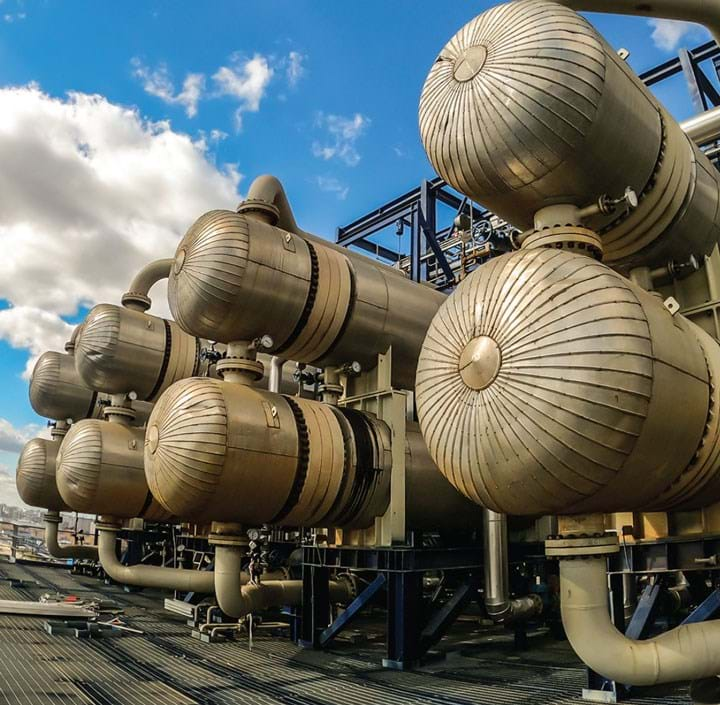Selecting the right heat exchanger is crucial for ensuring optimal performance, efficiency, and longevity in industrial applications. Heat exchangers are used to transfer heat between two fluids without them mixing, and their effectiveness directly impacts the overall efficiency of a process or system. Various industries, including chemical processing, power generation, HVAC, and manufacturing, rely heavily on heat exchangers to manage temperature regulation.
Types of Heat Exchanger
- Shell and Tube Heat Exchanger: This is one of the most common types, featuring a series of tubes through which one fluid flows, while the other fluid flows around the tubes within a shell. It is widely used in industries like chemical processing and power plants due to its ability to handle high pressures and temperatures.
- Plate Heat Exchanger: Comprised of thin, corrugated plates stacked together, this type offers a compact design with high heat transfer efficiency. Plate heat exchangers are often used in applications where space is limited and high efficiency is required, such as in HVAC systems and food processing.
- Air-Cooled Heat Exchanger: Instead of using water or another fluid, air-cooled heat exchangers use air as the cooling medium. These are ideal for industries in areas with limited water resources or where water usage needs to be minimized, such as in oil refineries and petrochemical plants.
- Finned Tube Heat Exchanger: This type of heat exchanger enhances heat transfer efficiency by using fins on the tubes, allowing better heat dissipation. Finned tube heat exchangers are often employed in air heating and cooling applications, including HVAC systems.
- Double Pipe Heat Exchanger: This design features two concentric pipes, with one fluid flowing through the inner pipe and the other through the annular space between the pipes. It is suitable for smaller-scale applications where simple and compact designs are required, such as in heat recovery systems.
Application-Specific Considerations
- Chemical Industry: In chemical processing, corrosive fluids and extreme temperatures are common, making material selection crucial. Shell and tube heat exchangers are often preferred for their durability under extreme conditions.
- HVAC Systems: For HVAC applications, energy efficiency and compact design are key. Plate heat exchangers are often chosen due to their high efficiency and small footprint, making them suitable for commercial and industrial buildings.
- Food and Beverage Industry: In the food industry, sanitary requirements are critical. Heat exchangers must be easy to clean and maintain to prevent contamination. Plate heat exchangers made from food-grade materials are commonly used in pasteurization and other temperature-sensitive processes.
- Power Generation: Power plants require heat exchangers that can handle high temperatures and pressures while maintaining reliability over long periods. Shell and tube heat exchangers are the standard choice in power generation for their ability to withstand such demanding conditions.
Heat Exchanger Sizing and Performance Optimization
- Heat Load: The amount of heat that needs to be transferred is one of the most critical factors in determining the size of the heat exchanger. Accurate calculation of the heat load is essential for choosing the correct size.
- Flow Rates: The flow rate of the fluids through the heat exchangers affects the rate of heat transfer. Higher flow rates can improve heat transfer but may also increase pressure drop, requiring more energy to pump the fluids.
- Temperature Differential: The temperature difference between the two fluids impacts the size and type of heat exchanger. A higher temperature differential can allow for a smaller heat exchanger, while a smaller temperature differential may require a larger surface area to achieve the desired heat transfer.
- Pressure Drop: A significant pressure drop across the heat exchangers can affect the overall system performance and increase energy consumption. It is important to balance heat transfer efficiency with pressure drop when sizing a heat exchanger.
Industry Standards and Compliance
- ASME Standards: The American Society of Mechanical Engineers (ASME) sets standards for the design, fabrication, and inspection of pressure vessels, including heat exchangers. Compliance with ASME standards ensures that the heat exchanger is built to withstand operating pressures and temperatures safely.
- TEMA Standards: The Tubular Exchanger Manufacturers Association (TEMA) provides guidelines for the design, fabrication, and maintenance of shell and tube heat exchangers. These standards help ensure that heat exchangers meet industry requirements for performance and durability.
- ISO Standards: The International Organization for Standardization (ISO) sets international standards for various industries, including heat exchanger design and performance. Compliance with ISO standards ensures that the heat exchanger meets global quality and safety requirements.
Flow Arrangement Types
- Parallel Flow: In parallel flow heat exchangers, both fluids flow in the same direction. This arrangement is less efficient than others, as the temperature difference between the fluids decreases along the flow path, reducing the heat transfer rate.
- Counterflow: Counterflow heat exchangers have fluids flowing in opposite directions. This arrangement is more efficient because it maintains a higher temperature difference across the heat exchanger, resulting in better heat transfer.
- Crossflow: In crossflow heat exchangers, the fluids flow perpendicular to each other. This design is often used in air-cooled heat exchangers, where air flows across the tubes or fins while the fluid flows inside the tubes.

